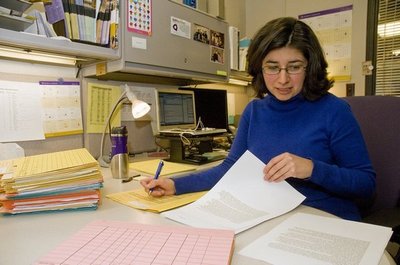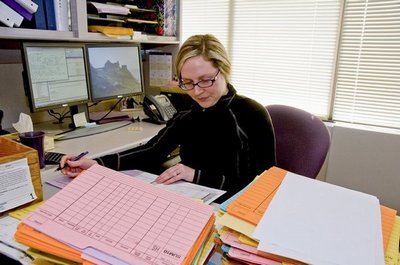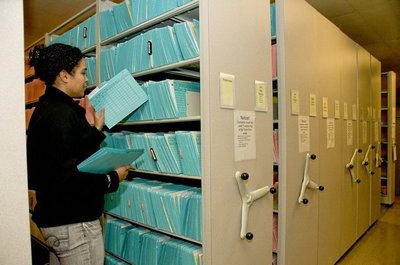February 25, 2010
Admissions staff work together to process avalanche of autumn applications
It’s become a kind of mantra that in lean times, UW offices must do more with less — and this time of year, nowhere is that more true than at the Office of Undergraduate Admissions. In fact, the office is closed to new business through March 5 just to work through the avalanche of freshman applications for autumn quarter.
The counselors and staff in admissions don’t mean to be rude, of course — they just have to concentrate on processing those application packages and getting replies to students in a timely manner. About 22,700 freshman applications have come in this year, compared to 21,000 this time in 2009. At this time in 2006, there were about 16,700.
“We have an increasing number of applications, so the work is increasing, and with budget cuts we have reduced resources, fewer staff to process the applications,” said Paul Seegert, associate director for operations for the Admissions Office. “But we just keep getting more and more applications.”
The deadline for freshman applications is Jan. 15, but the office starts getting them as early as October, Seegert said, and they arrive in droves come December. He said the UW will make offers of admission to about 12,000 of the 22,700, expecting that ultimately about 5,500 of those students will attend the UW next fall. “We actually do make offers of admission all along to the strongest applicants,” Seegert said. “We’ve already made many offers of admission and have many more to go.”
After the freshmen applications for fall come the transfer applications, which also must be reviewed. The office will get about 5,000 transfer applications in all, and about 1,800 students will ultimately enroll.
The UW has dropped spring quarter as an admission quarter beginning in 2011. “I don’t know how we would have survived had we not done that,” Seegert said. But this year many spring applications are yet to be processed. “We’re doing all the work for spring quarter but we’re also trying to finish with the autumn freshmen — really, right now, both are going on.”
Every application is reviewed by two sets of staff, Seegert said. The first of these, the Processing Unit, ensures the application is complete with needed test scores, personal statements, transcripts or other documents, and often communicates with students to secure these. Myria Stevens, a counseling services coordinator in admissions, is among this group. Stevens said one of the best parts of her job is when she hears later from students whose applications she assisted. “It’s neat to get thank-you cards from applicants or to be able to speak with someone on the phone and they are so thankful — it’s so important for them to be able to speak with someone and get that special attention.”
The next, and deeper reading is called a Holistic Review. This is where an admissions staff member personally engages with a student file, reading the essays and statements and closely reviewing which classes the student took. This closer review enables the reader to include such factors as personal circumstances, income status and whether students are the first generation of their family to attend college. Such information adds context to the mostly numbers-based file. Seegert said, “This allows us to shape our class better, so we have a strong and diverse freshman population.”
Among those doing the Holistic Reviews is Liz Mendez, a lead counselor for admissions. Mendez said she reviews academic and personal factors in the file to generate a holistic assessment for each application. She reads the students’ personal essays and other writing, and said “the best ones are where I can kind of visualize the student on our campus.” Student writing about extracurricular activities and interests “gives us a better picture of what they’re doing outside the classroom,” she said. “Every student brings something different.”
Mendez said she spends much of fall traveling to recruit students, so the winter, though busy, brings a different type of work. “I feel like in fall it’s talk, talk, talk, and then in winter it’s read, read, read!”
A reader will read maybe 50 application files in a work day, or 70 or more in a 10-plus-hour marathon reading session, Mendez said. “You get pretty good at it — you know exactly what you are looking for. The thing that takes the most time is reading the essays.”
Admissions work comes in cycles, but it never stops, Seegert said. “The work never ends, because after we admit the students, then we have to evaluate transfer credits for them, then before each quarter starts we have to get final transcripts for them and make sure they finished all the classes they said they were going to take — there’s absolutely no break.”
As the deadlines approach, the applicants tend to grow more anxious. They want to know the status of their file, so they call, e-mail or even drop in. “But every time … it slows us down from evaluating their applications,” said Seegert. “So it’s really in their best interests to let us do our work and if we need something, we’ll contact them.”
With such a huge cycle of work, it’s worth asking, how do they get it all done in time?
The answer, simply put, is cooperation, teamwork, focus — and a little extra help. Seegert said the office hires about 20 graduate student readers part-time every year to help, in addition to the 20-some permanent staff who read. Employees from the Office of Minority Affairs & Diversity also help read admissions applications, and indeed collaborate with the office throughout the year, especially in outreach and recruitment efforts.
“We have a great team, really,” Stevens said. “And the nice thing about our office is that all the different areas chip in when needed. We all just kind of go in cycles and help each other out when needed.”
Mendez agreed. “We’re very lucky in our office to have a dedicated staff who always brace for this time of year. And we’re always working together and collaborating … we pull together because we know it’s going to be a lot of work.”
One also might ask — Isn’t this all done online by now? “No,” said Seegert. “We wish it were.”
He said most applicants apply online but since the office lacks an image management system “we basically print out all those applications.” He said most of the UW’s peer institutions have online application processing and that it’s hoped the UW will implement such a system within the next one or two years. “In my view it has to happen,” Seegert said, “because when you get to a certain volume, trying to push paper around, it’s — it’s — difficult.”
And so we come back around to the partial office closure through March 5. With fewer staff and an ever-increasing workload, Seegert said, it’s necessary to allow them time enough to finish their work.
“By closing to non-urgent calls we think that will give us the time to do our work with the level of quality we’ve always done it — and get the decisions out when we say we will.”
Mendez added that it helps that the admissions staff care deeply about their work. “It’s stressful, but it’s also a very fulfilling piece of everything we do through the year.”





